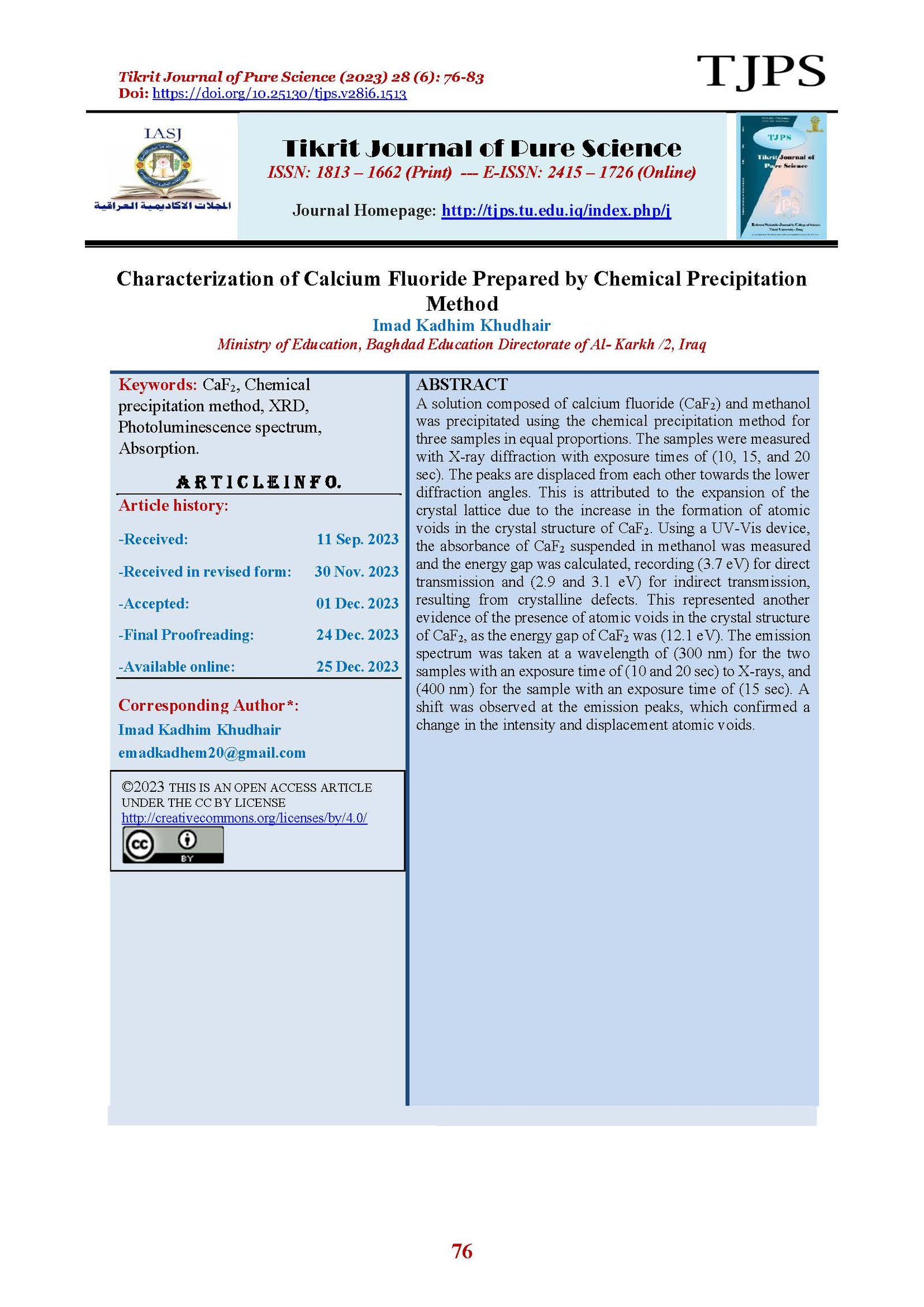Characterization of Calcium Fluoride Prepared by Chemical Precipitation Method
Main Article Content
Abstract
Calcium fluoride (CaF2) was precipitated using chemical precipitation method. The quantity was divided into three samples. The X-ray diffraction of samples was clear. The peaks were displaced from each other towards the lower diffraction angles. This is due to an expansion of crystal lattice due to an increase in the formation of atom voids in crystalline structure of compound CaF2. The results of absorption were clear. The energy gap for direct transmission is (3.7) eV and for indirect transmission is (2.9 and 3.1) eV. Evidence for the existence of atom voids. From the results of photoluminescence spectrum at excitation with a wavelength of (300) nm for the first and third samples and for second sample with (400) nm, a shift was observed in peaks as a result of change in density of atom voids and their displacement. The fluorescence spectrum also shifts towards longer wavelengths with increasing exposure to X-ray diffraction.
Article Details

This work is licensed under a Creative Commons Attribution 4.0 International License.
Tikrit Journal of Pure Science is licensed under the Creative Commons Attribution 4.0 International License, which allows users to copy, create extracts, abstracts, and new works from the article, alter and revise the article, and make commercial use of the article (including reuse and/or resale of the article by commercial entities), provided the user gives appropriate credit (with a link to the formal publication through the relevant DOI), provides a link to the license, indicates if changes were made, and the licensor is not represented as endorsing the use made of the work. The authors hold the copyright for their published work on the Tikrit J. Pure Sci. website, while Tikrit J. Pure Sci. is responsible for appreciate citation of their work, which is released under CC-BY-4.0, enabling the unrestricted use, distribution, and reproduction of an article in any medium, provided that the original work is properly cited.
References
[1] Faraji, S., Ghasemi, S. A., Parsaeifard, B., & Goedecker, S. (2019). Surface reconstructions and premelting of
the (100) CaF2 surface. Physical Chemistry Chemical Physics. (21):29,16270-16281.
[2] Nelson, J.R., Needs, R.J., and Pickard, C.J. (2017). High-pressure phases of group-II difluorides:
polymorphism and superionicity. Phys. Rev. B, 95:054118.
[3] Nelson, R.J., Needs, R.J., and Pickard, C.J. (2018). High-pressure CaF2 revisited: A high temperature phase
and the role of phonons in the search for superionic coconductivity. Phys. Rev. B, 98(22):224105.
[4] Hahn, D. (2014). Calcium Fluoride and Barium Fluoride Crystals in Optics. optical materials. V(9), I(4):45-
48.
[5] Mohammed, A.J., Abdullah, M.A., et all. (2023). Study of optical, structural and electrical properties of CuO
films prepared by chemical bath deposition with laser at different concentrations. Tikrit journal of pure
science. V(28):2. doi.org/10.25130/tips.v28i2.1339.
[6] Murugan, G.S., Petrovich, M.N., et all. (2011). Hollow-bottle optical microresonators. Optics Express,
19(21):20773-20784. doi.org/10.1364/OE.19.020773.
Tikrit Journal of Pure Science (2023) 28 (6): 76-83
Doi: https://doi.org/10.25130/tjps.v28i6.1513
83
[7] Matsko, A. (2019). Practical Applications of Microresonators in Optics and Photonics. (CRC Press).
[8] Hall, D. and Jackson, P. (2020). (e book) Physics and Technology of Laser Resonators. (CRC Press).
[9] Bykov, V. and Silichev, O. (1995). Laser Resonators. (Cambridge Intl. Science Publ.).
[10] Kudryashov, A. and Weber, H. (1999). Laser Resonators. Novel Design and Development (SPIE Press).
[11] Hodgson, N., and Weber, H. (2005). Laser Resonators and Beam Propagation. 2nd edition (Springer).
[12] Dixit, S.K. (2001). Filtering Resonators. (Nova Science Publishers).
[13] Rabus, D.G.(2007). Integrated Ring Resonators. The Compendium (Springer) Rayleigh L., Philos. Mag., 20(1910):1001.
[14] Tahvildari, K., Ghammamy, M., Nabipour, H. (2011). CaF2 nanoparticles: Synthesis and characterization. Spring Int. J. Nano Dim. 2(4):269-273.
[15] Fred, S. (2015). Physical Foundations of Solid-State Devices. Rensselaer Polytechnic Institute Troy NY, USA.
[16] Cullity, B.D. and Stock, S.R. (2001). Elements of XRay diffraction. (3rd ed.), Prentice Hall.
[17] Panda, S., Antonakos, A, Bhattacharya, S. and Chaudhuri, S. (2007). Optical properties of nanocrystalline SnS2 thin films. Mater Res Bull 42:576–583. doi:10.1016/j.materresbull.2006.06.028.
[18] WahabH. (2012). Metal oxide catalysts for carbon nanotubes growth: The growth mechanism using NiO and doped ZnO. PhD. Thesis, University of York.
[19] Jiaqi, C., Yuzheng, G. and John, R. (2022). Electronic properties of CaF2 bulk and interfaces. Journal of Applied Physics, 131:215302. doi.org/10.1063/5.0087914.
[20] Mir, A., Zaoui, A. et all. (2018). The displacement effect of a fluorine atom in CaF2 on the band structure. Applied surface science 439. doi:10.1016/j.apsusc.2017.12.257.
[21] Hasabeldaim, E.H.H., Swart, H.C. and Kreem, R.E. (2023). Luminescence and stability of Tb doped CaF2 nanoparticles. RSC advances, 8(13):5353-5366. doi.org/10.1039/D2RA07897.
[22] Anees, A.A., Majeed, M.A. et all. (2023). Influence the host lattices on photoluminescent properties of the Ce/Tb doped CaF2, NaYF4, and NaGdF4 nanoparticles. journal of fluorine chemistry, V270.110174. doi.org/10.1016/j.jfluchem.
